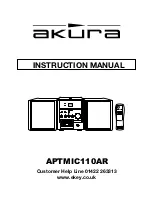
18
• The Master 2-output can be connected via the RCA-sockets. Make sure that the sockets are set properly (L
& R).
• Via the BOOTH sockets, you can either connect monitor active speakers for the DJ-booth or an additional
amplifier for creating a second zone.
• For recording, connect your tape recorder or cassette deck to the REC OUT-sockets. The REC OUT level
will not be influenced by the master fader. You can set the output level with the channel faders, the tone
controls and the GAIN control.
• The CM-740 features one separately controllable microphone channel (MIC 1). This microphone can be
connected via the XLR mounting-socket on the frontpanel or via the ¼" mono jack plug on the rearpanel.
With the Talkover-selector, you can attenuate the level of all other signal-sources without affecting the
microphone volume.
Occupation balanced XLR-socket:
B alanced X LR -socket:
*URXQG
,Q 3KDVH
2XW RI 3KDVH
1
2
3
Occupation unbalanced mono-1/4“ jack-plug:
U nbalanced m ono 1/4“ jack-plug:
Tip
I P h
( )
G
d
Sleeve
• Additionally, the CM-740 features one more ¼" Mic 2 jack plug on the rearpanel. You can adjust the
microphone volume using the and CH-4 fader. Make sure that the MIC 2 /LINE 4-switch is set to MIC 2.
• Via the PHONO / AUX-selector on the rearpanel, you can determine whether you want to connect a record
player (PHONO) or other devices (AUX) to the respective channel. Please set the selector before you install
the mixer in your rack.
• You can connect up to 3 record players using the PHONO 1 sockets, PHONO 2 sockets and PHONO 3
sockets on the rearpanel. You can only control the record player signal after you switched the PHONO /
LINE switches to PHONO. The signal is then controlled via the CH-1, CH-2 and CH-3 faders.
• Connect your tape recorder, tuner, CD-player, cassette deck or all other line signals to the LINE /AUX
sockets on the rearpanel. You can only control the line signals after you switched the PHONO/LINE switches
to line. The signal is then controlled via the respective faders.
• Sound-effectors are to be connected with the EFFECTS-sockets. In this way, you can include additional
sound-effects.






































